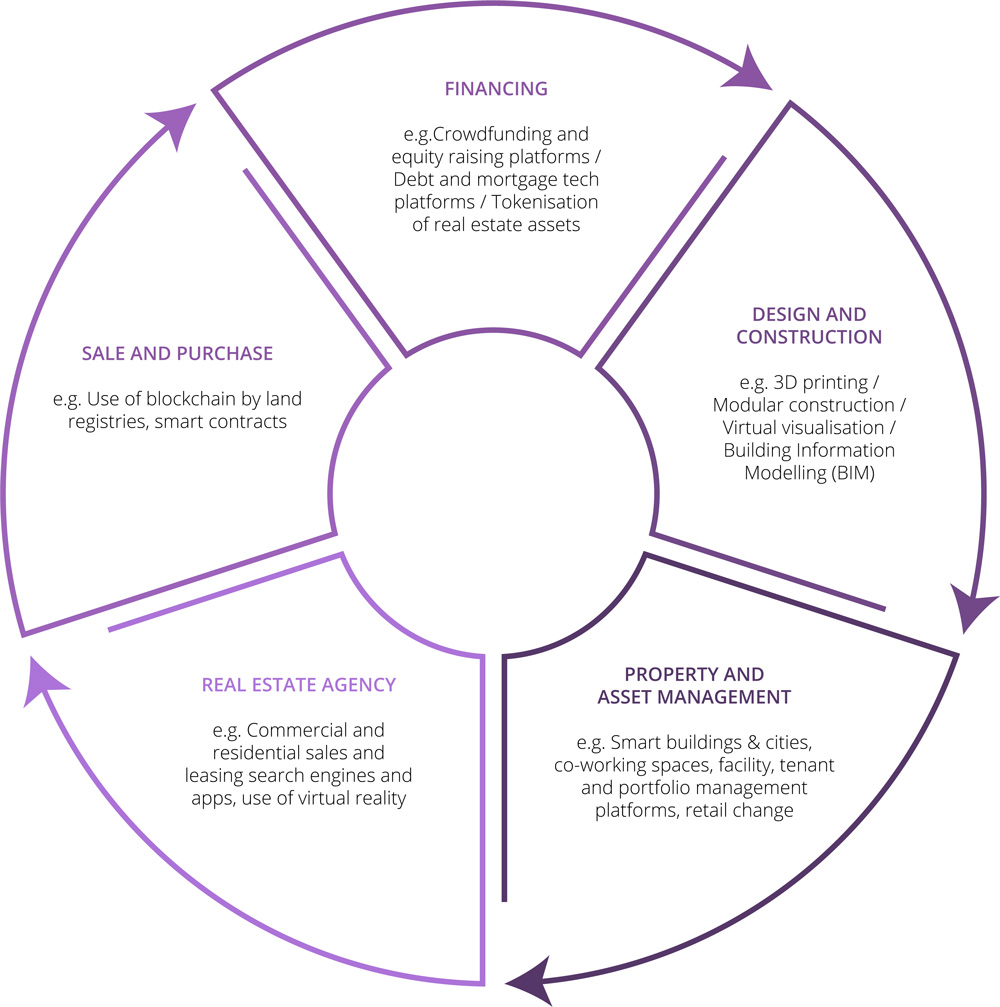Proptech (Part One): Smart Buildings, Co-Working Spaces, Effects on the Retail Sector and Autonomous Vehicles
Ian Arnott - Head of Hospitality Development - Real Estate
The term ‘Proptech’ is a broad one which encompasses a wide range of new technologies which seek to make the construction and real estate industries more efficient and streamlined. The term is also used in the context of examining the present and future effects of advances in technology on the real estate sector. As illustrated below, Proptech is becoming increasingly prevalent at every stage of a real estate asset’s life cycle from financing and construction through to its disposal.

In the first of two articles focussing on Proptech we take a look at some of the effects of new technology on the built environment and its disruptive effects on how real estate assets are being designed, used and operated.
Smart Buildings
A smart building is, essentially, one that uses interconnected technology to share information about the building between its various systems to make it more efficient and to enhance the experience of those using the building.
Core building systems, such as those controlling heating, ventilation, air-conditioning, lighting and security, are usually linked together digitally and inform each other in order to automate various processes. For example, sensors and data gathering devices may be used to provide data on footfall and where occupants are located in the building at any given time so that the interior environment can be regulated accordingly in terms of temperature and light. System failures can also be more quickly and accurately identified and potentially dealt with remotely.
A smart building is also more likely to be designed to be more environmentally friendly and cost efficient in terms of energy wastage.
Unlike a normal building, a smart building is also constantly gathering data on itself. Such raw data may, for example, be used by occupiers to use space in their premises more effectively or to provide landlords with hard evidence in which to promote the advantages of their building to corporate occupiers. However, such data collection needs to be carefully managed in terms of protecting the personal data of a building’s occupants and users.
On the downside, end users of smart buildings may feel a disempowering effect with such reduced control over their environment. In addition, as smart buildings start to resemble a giant Internet of Things device, the large attack surface does create cyber security concerns and there have already been some cases of hacks where building systems have been compromised by those with criminal intent.
Nevertheless, smart buildings are a trend that can only evolve and grow in the future and developers of both residential and commercial real estate assets will increasingly make use of smart technology to maintain a competitive edge.
Co-working Spaces
Co-working spaces are a relatively new type of working environment that exist somewhere between the traditional office and working from home. Although similar to the existing serviced offices model, they differ in that there is a much greater emphasis on the different users sharing the space, their knowledge and ideas and equipment to create a more vibrant and collaborative place of work. They have flourished in recent years where cheaper, lightweight wifi enabled laptops and a more mobile, agile workforce has led to more flexibility in the places where we are able to carry out our work.
There are a lot of different formats offerings in the co-working space. However, a typical arrangement for end users would be:
- paying an all-inclusive, fixed daily or monthly rate with the right to terminate the arrangement on relatively short notice;
- a range of options such as private offices or a dedicated/hot desk in a shared, open space;
- inclusive wifi, reception, security and cleaning services;
- option to book meeting rooms for an extra cost (some booking credits may be included in the fixed price);
- 24/7 access;
- invites to exclusive networking and community events; and
- additional benefits such as being able to hot desk at other co-working spaces operated by the same company in other jurisdictions around the world and access to unlimited complimentary beverages.
They are a particularly attractive option for a start-up company, particularly in the more creative industries, where end users can interact, collaborate and socialise with like-minded peers in the same field without being locked into a lease or being subject to other overheads associated with renting office space.
However, established large business are also making use of co-working spaces. This is for a number of reasons, which include:
- getting closer to start ups and entrepreneurs to understand what is happening on the ground, keeping an eye on future industry disruptors and to build relationships;
- a need for more flexible space outside of a traditional lease model;
- using such spaces for its employees in overseas locations where it does not have offices or where it wants quick access to a new market;
- encouraging employee creativity by placing them in an environment with an entrepreneurial mind-set; and
- attracting employees and increasing employee retention by offering such alternative working environments (particularly to those employees that may live outside of big cities).
On the negative side, such co-working spaces may not be for everyone and some may have concerns regarding cyber-security, confidentiality and privacy, potential distractions and the effect on productivity of working in such an environment.
Nevertheless, the recent growth of the sector has been huge, particularly in the US and Europe, and it shows no real signs of slowing down as it continues to expand into other markets such as India, China and South East Asia. Jones Lang La Salle, for example, has predicted, in relation to the US office market, that “Given industry shifts, flexible workspace and shared amenity spaces are projected to encompass approximately 30% of the office market by 2030“. We are also likely to see other types of real estate assets such as retail and hotels offering co-working products in the future to maximise and monetise use of space and for more niche products targeted at a particular industry or type of customer (e.g. co-working spaces with childcare facilities) to develop.
Retail Sector Changes
The number of closures of brick and mortar retail stores continues unabated in 2019, particularly in the US and Europe. The main and most obvious factor cited is the inexorable rise of e-commerce and online shopping – the ‘Amazon Effect’. Whether this amounts to a so called ‘retail apocalypse’ or merely a Darwinian weeding out of those retailers that fail to adapt to shifting customer preferences and habits remains to be seen. However, what is clear is that those retailers that are boxing clever in the format of their brick and mortar offerings have a much greater chance of weathering the tech storm.
As we have been hearing for years in relation to the Millennial generation – it’s now all about ‘experience’. Sales per square foot are becoming less important as physical retail space morphs into a place where, of course, customers continue to make purchases (sales from brick and mortar stores still dwarf online sales), but also where retailers now showcase their goods and services and offer fun and interesting activities and interactions with the brand. Such experiential retail can range from a clothing store that offers high tech fitting rooms that make use of virtual and augmented reality; a pet store that provides animal workshops for children or classes on pet nutrition or grooming; to a sporting or outdoor goods store that has a climbing wall or sports simulators.
In what has long been a phenomenon with shopping malls in Dubai, with their indoor ski slopes, aquariums and ice rinks, it is also likely that there will be a rise in ‘destination malls’ which serve as multi-faceted entertainment hubs offering experiences that cannot be accessed or bought online.
In addition, those retailers that create a strong interaction between their online presence and physical stores are also likely to maintain a competitive advantage. For example, many retailers are starting to introduce so called ‘click and collect’ whereby goods can be ordered online and collected in the store or allowing unsatisfactory goods purchased online to be returned in person at the store.
However, this shift towards e-commerce has other knock on effects on the real estate industry. Whilst, logistics companies and warehouse operators may be thriving, it creates obvious concerns for shopping mall owners and landlords which typically employ a turnover rent model with their retail leasing.
There are many variations in how a turnover rent clause in a retail lease may be configured. However, in essence, such leases involve some or all of the rent payable by the retail tenant to be directly linked to the gross sales generated from the leased premises. With the declining number of sales made in-store, this has a negative effect on a landlord’s return under a traditional turnover rent lease. The nature of turnover rent is therefore changing. For example, landlords may perhaps seek a different allocation between fixed and turnover rent for those retailers selling products that are more prone to physical showcasing, such as electronics. Additionally, what exactly is captured by the definition of turnover/gross sales in the lease is becoming more contentious in negotiations – for example, landlords may seek to include those online sales that can be linked to the physical premises, such as those goods ordered online and then collected at the physical store or seek to exclude any reductions in turnover caused by having to exchange goods bought online with those held at the store. As the ability to differentiate between goods purchased at, or with a connection to, the physical store and those bought online becomes increasingly fuzzy, turnover rent clauses will need to adapt accordingly in order to maintain a fair allocation of risk between landlord and tenant.
Autonomous Vehicles
Despite all the hype and the rapid progress of recent decades, autonomous vehicle technology is still in its relatively early stages. The Society Automobile (SAE) International published a standard in 2016, which is now widely referred to, which defines six levels of driving automation, with level 0 being no automation and level 5 being full automation, where the need for any kind of human driving in any conditions is completely eliminated.
Levels 1 and 2, which have already been achieved, are driver support technologies that assist with such matters as steering, lane centring, cruise control and assisting with braking and accelerating. At present, car makers are just starting to introduce models with Level 3 (‘Conditional Automation’) technology which is where a human driver is still required but the vehicle can make informed decisions for itself based upon the environment around it, such as overtaking a slower moving vehicle. However, human intervention is still required when the vehicle is unable to execute the task such as in adverse weather conditions. For obvious safety reasons, it is expected that many car manufacturers will skip Level 3 and head straight to Level 4.
Level 4 automation is full automation. However, it has a more inferior environment detection system than a Level 5 vehicle and there may be certain off road conditions and terrains where it would not be able to function properly without a manual, human override. Such Level 4 technology is therefore likely to be first rolled out in private, carefully maintained and operated environments, such as airports or university campuses, with clear road markings and signage and purposely designed infrastructure in place.
However, although we may get to Level 4 and Level 5 automation in the next few years, it is likely to take much longer before such vehicles can be used on a mass scale on public roads, outside of pre-defined geographical areas. The development of such public road infrastructure will be largely outside of the control of the car manufacturers and will undoubtedly vary from area to area and country to country, although parts of new ‘smart cities’ may serve as a good testing ground. Such roll out will also pose a wide range of new and challenging legal and regulatory challenges that will need to be (manually!) navigated, such as the issue of liability for accidents.
Despite uncertainty as to when mass adoption of autonomous vehicles will occur, we can speculate on the potential effects on the real estate industry and urban planning of a future world in which all vehicles are fully automated. One of the most obvious effects would be on existing public and private space used as parking facilities, which takes up a surprisingly large proportion of the urban environment.
It is speculated that in such a world, autonomous vehicles would be able to pick us up and drop us off at our destinations on demand before returning to large, dedicated parking depots serviced by carmakers or operators. The prevalence of car ownership may also decrease with vehicles serving more as self-driving ‘robotaxis’ owned or operated by companies like Uber and available on demand at the click of an app. However it all pans out, we can be fairly certain that the need for parking space at our homes, workplaces, leisure and retail destinations and other places that we tend to visit by car will be significantly reduced in the future. This will inevitably require a significant amount of re-zoning and architects and developers of residential and commercial property may start to future-proof by considering how parking areas in buildings may be constructed to be more easily retrofitted for other uses.
The location of a real estate asset may also become less of a determining factor on property prices. As the time spent driving can be spent doing other things such as working, watching entertainment or sleeping, the theory, at least, is that we would become less concerned with travel times and less concerned with the location of a property in relation to other things. As a result, suburban sprawl may proliferate as commuting becomes more of a productive, pleasurable process. However, ultimately, the future effect of autonomous vehicles on urban planning and property prices remains uncertain. As stated in a 2018 article on the topic in The Economist, “Simply put, building cities around cars increases congestion, discourages the use of public transport and encourages sprawl, all of which urban planners generally disapprove of. The odd thing is that AV could either reverse or accelerate each of these trends. They could reduce or increase traffic; make affordable transport more or less accessible; and lead to denser cities or more sprawl. It all depends on the rules for their use, and in particular the pricing”.
In the second of our articles focusing on Proptech, we will explore the growing real estate fintech sector and take a look at whether blockchain is living up to its hype in terms of its application to the real estate industry.
For further information please contact Ian Arnott (i.arnott@tamimi.com).
Stay updated
To learn more about our services and get the latest legal insights from across the Middle East and North Africa region, click on the link below.





